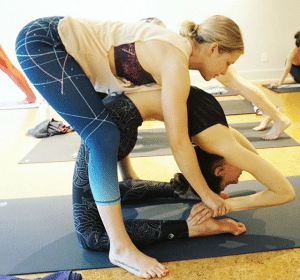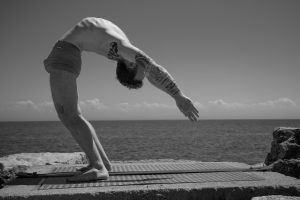When people who don’t practice Ashtanga take one look at the asanas (especially those in the more advanced series), they probably either think we are crazy, stupid or both.
I mean, they aren’t totally wrong, I do think we are a little crazy.
But crazy aside, Ashtanga is much more than just fancy asana. It’s not all handstands, and legs behind the head. It’s about connecting with your breath – learning to still the mind even in the most challenging of postures. After all, as David Robson says, asana without breath is just shitty gymnastics.
Yoga is the stilling of the changing states of the mind. – Yoga Sutras 1.2
Those who don’t practice Ashtanga however, don’t quite understand the point of these challenging asanas. Many are not afraid to share their opinions, and “Ashtanga bashing” has become a real problem.
Statistics show that 1 in 5 Ashtangis will face Ashtanga-related criticism in their lifetime.
I’m totally making that up, but it probably isn’t entirely inaccurate!

A few years ago my husband attended a non-Ashtanga teacher training and said he was given a hard time for being an Ashtangi. The other yogi’s called Ashtanga too “too harsh,” and “too rigid.” They were convinced the asanas were too difficult and would create injury in the body. They felt that the practice was not sustainable and that the sequence could not be done by everyone.
This isn’t the only time I’ve heard people question the methodology of Ashtanga. I see it on the internet, social media, and other platforms
Yet, despite this, every day thousands, (dare I say millions?!) of people wake up and walk the path of Ashtanga Yoga.
So what’s with all the Ashtanga bashing?
To me, it seems that it stems from Ashtanga’s physicality. The intense 6-day-a-week commitment, the challenging asanas, and the seeming rigidity of the practice.
While these qualities may give Ashtanga a bad name in the eyes of onlookers, those who walk the walk know different.

Ashtanga is not an exercise regime – it is a spiritual practice.
Practicing 6 days a week can seem like a daunting task to those just beginning, or looking in from the outside. It also defies traditional exercise protocols which advocate strategic rest periods for optimal muscle recovery.
But the thing about Ashtanga is, it’s not an exercise program. It is a devotional practice. It is a daily ritual in which you connect deeply with your breath, and practice stilling the mind. That is the intention behind the Ashtanga method.
David Robson says that while physical health and strength may come as a byproduct of this daily practice, physical strength is not the goal of Ashtanga.
Practice becomes firmly established when it has been cultivated uninterruptedly and with devotion for a long period of time – Yoga Sutras 1.14
In order to achieve yoga, one needs to practice consistently, over a long period of time. Like, say, 6 days a week, every week forever?
See, we’re not making this up. It’s in the Sutras.
Kino Macgregor also has a great article on the logic behind a 6-day a week Mysore practice.
So, if Ashtanga is a spiritual practice, and the goal isn’t physical strength, why practice asana in the first place? I’m glad you asked.
David explains this perfectly in his latest video, “Why Asana is Important.”
Here’s what I took from it:
Asanas are meant to keep you at your edge.
Notice how I said YOUR edge. Not David’s edge. Not Sharath’s edge. Not Kino’s edge. YOURS.
If you can’t do advanced asana, that’s perfectly fine. To walk this path you don’t have to be able to grab your ankles in a backbend or balance on your arms with your feet on your head. You don’t even have to be able to touch your toes in a forward bend if your body won’t allow it. That isn’t a requirement.
Many people may never go past half primary because their body simply won’t move that way. And that’s ok! It doesn’t mean you’re any “less” of an Ashtangi. It doesn’t mean that you’re not going “deep” enough in your practice. That’s not what performing asana is about.
We use asana’s as screens. Screens to reveal the impermanent nature of our thoughts and feelings. – David Robson

Ashtanga is about showing up every day, and meeting yourself at your edge – whatever that looks like for you. It’s about noticing what comes up in each asana. And maybe noticing that each day your thoughts, feelings and physical sensations are a little different.
It’s easy to get attached to the physical part of the practice. To identify with the asanas. To let them define you as a practitioner. It’s easy for the ego to rear its ugly head and have you force yourself into postures that you’re just not ready for. I’ve been there, and if you’ve been practicing for a few years, chances are, so have you.
And it’s in these moments, that injury can happen. In my experience, whenever I have hurt myself during my practice, it’s as a result of me pushing too hard, too soon. It’s a result of me not listening to my body, or trying to “impress” my teacher. It’s at the hand of my ego.
In these moments it’s easy to lay blame on the practice, rather than taking responsibility for your choice to push yourself beyond what your body is capable of. Yes, injury can and does happen in Ashtanga. But it’s not because Ashtanga is an inherently flawed practice that injures all those who walk its path. Often, it is as a result of not paying attention to important cues in the body, or normal wear and tear.
Ashtanga yoga is for everybody
Ashtanga yoga has been around for a long time, and it’s probably not going anywhere anytime soon. Whether you’re a pregnant woman, in your mid-60’s like our good friend Betty, or are completely new to yoga, you can practice Ashtanga.
How long have you been practicing Ashtanga, and what’s your experience been like? We’d love to hear from you in the comments section below!

8 months mysore style here in NYC. Love it!! Life changing
Awesome, Tohmas!
Thank you for this post. Perhaps we should welcome criticisms etc. as gifts from the Creator rather than what is perceived by many as an irritant.
In my opinion, much of what is encouraged in Ashtanga Mysore rooms is the disarmament of self in the context of a safe space. For this to happen for me I need that safe space which in turn shall hopefully facilitate listening to what is communicated to me from my own centre.
Questioning my beliefs and inviting constructive criticism from other’s experiences is essential to becoming more fully human.
If someone ever meets that person who has all the answers in life I suggest you may be better off earnestly listening to those that we believe to be broken.
Peace always.
Thanks Ed, totally agree with your sentiments on the Mysore room. It’s a special place.
thank you so much for this posting AYCT!. I have been practicing (Ashtanga) for 11 years and at 63, it is the most important part of my day. It is my time to connect with my inner sanctum, and join (unite) with the prana of the universe.
Thanks John! Couldn’t agree more! As a new mama, Ashtanga is definitely the most important part of my day too 🙂
I love your explanation of the asanas. To me quieting the mind is fundamental in our busy lives. We honour ourselves on how busy we are as opposed to how quiet our mind is … and that’s destruction in the making.
I’ve been practicing yoga since January 2016 … and following the Ashtanga methodology since March 2016 which I fell in love with almost immediately especially because other people didn’t. Hahaha I think we’re a group of rebel minded people. Lol My love of this has exploded so quickly (part of my personality) that I took my Ashtanga teacher training and am now teaching It has changed my mind, my body and my spirit (soul). It’s been nothing short of profound for me! I think I’m a lifer! Lol
… thanks again for a great article!
Thanks Cheryl! So glad you liked it 🙂
I think those who criticize the Ashatanga method on the basis that it has the potential to create injury have a valid point… Ashatanga in its authentic form is not accessible to the majority of the western population and our cosmopolitan, sedentary lifestyle. Also in north America we tend to have an overachiever, competitive mentality so naturally this attitude will translate onto the mat. It is highly likely that the new or less mature practitioner will yearn to emulate their teacher’s or other more advance students’ athletic prowess and thus “force” progression beyond their own body’s abilities… this is why there are more injuries in Ashtanga yoga than other forms. We cannot deny those facts. I have nothing against Ashtanga as I myself practiced it for several years but eventually I had to modify my practice due to severe cervical disk damage and an advanced stenosis- I could no longer afford the pressure of having my legs behind my head right. I guess my point is Ashtanga does have the potential to injure students and so we must acknowledge that for some, other forms of yoga are much more appropriate and in general we should embrace all different forms of yoga practice. What matters is what happens to our mind when we practice – if doing a Yin style practice allows you to look inward, still your mind and attain a higher state of consciousness than that is the TRUE yoga practice.
Jade thank you so much or your comment. I totally agree with what you’ve presented here. I do think Ashtanga can be appropriate for everyone, if it is approached in a responsible manner, but you’re spot on about newer/less mature students trying to emulate their teachers. I was definitely one of those students, and have since learned my lesson as a result of injury. And I love what you’ve said about practice and the mind. There’s a great podcast called “Chitheads” on yoga philosophy, and in one episode he interviews Eddie Stern. They talk all about injury and Ashtanga, and the yoga sutra’s. He says, “The sutra’s tell us that yoga is the stilling of the mind, but they don’t tell us how we get there.” Any sadhana is good sadhana 🙂